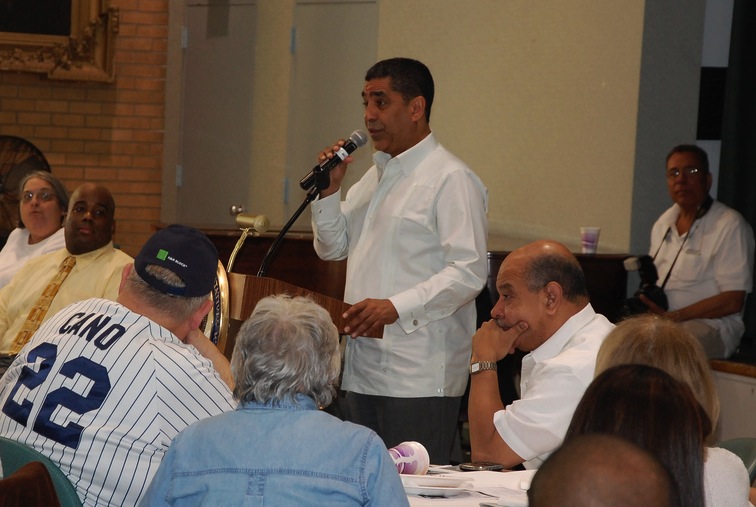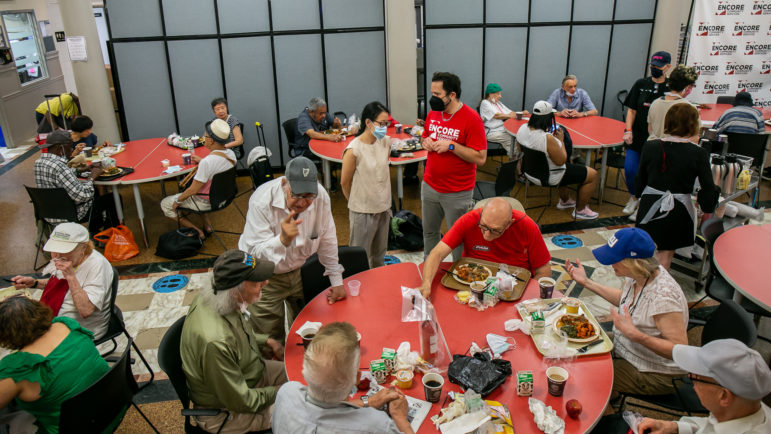
RepRangel
Sen. Espaillat, seen at a community meeting. He has run two serious but unsuccessful campaigns for Congress in a district redrawn in 2012 to include more Latino voters, especially in the Bronx.
The Democratic Party primary held on June 24th for the 13th Congressional District was a contentious one, pitting the Dominican-born challenger Adriano Espaillat against Harlem’s native son, incumbent Charles Rangel, for the second time in two years, and the political fallout was predictably intense following Rangel’s victory.
But while there was much talk about apparent racial conflicts between the black core of Central Harlem and the emerging Dominican power base in Washington Heights, the real drama was rooted in the redistricting battle that redrew the lines of the district back in 2012.
The question now, as Rangel gets set to head to Washington for a 23rd term and Espaillat fights to retain his state Senate seat in a September 9th primary, is: Did the district perform as the district-drawers hoped?
The answer hinges on what the motive was behind creating the city’s third Latino-majority congressional district. And as is often the case in New York City politics, that depends on whom you ask.
“The point of redistricting is not to guarantee any particular candidate or any particular ethnicity [that] a person of that ethnicity will be elected,” says Susan Lerner of Common Cause, a political reform advocacy group that closely monitors redistricting efforts. “The point is to give communities a fair opportunity to elect someone of their choice, which could be someone of a different ethnicity or it can be somebody who they feel is Hispanic but half-Puerto Rican instead of Dominican.”
The reference to Rangel’s mostly downplayed Puerto Rican heritage is emblematic of the complexities of what happened in District 13: Yes, Rangel is half-Puerto Rican, but it could be said that Puerto Ricans (and perhaps other Latino ethnicities) helped him win not because of that, but because in this case, they preferred a black man with whom they shared common interests.
“I voted for Rangel because he started UMEZ and authored legislation that advanced the causes of minorities across the city,” said John Rivera, a voter of Puerto Rican descent who lives in East Harlem. “My vote wasn’t racially motivated. During the Bush administration they named a Latino attorney general but that didn’t excite me. I’m proud to be Latino and see Latinos in high places, but they have to align with my value system and beliefs.”
Two goals and a lot of maps
The redistricting of 2012 seemed to have two motives. One involved protecting voting rights and the other revolved around the democratic goal of establishing a third “electable” Latino-majority district—if Latinos could express their community interests through another majority district, they might choose to elect one of their own.
An early plan, proposed by the Dominican National Roundtable, would have created a tri-county district that included Queens, an effort to capitalize on that borough’s increase in Latino population.
“But the law does not allow you to draw a district on the basis of race or a particular group,” says Esmeralda Simmons of the Medgar Evers Center for Law and Social Justice, who was involved in the process. “We wanted to keep the district under control of people of color, and preserve Harlem’s core, not split it up.”
Espaillat maintains that the tri-county plan was not his idea, and was just one of several approaches suggested during the redistricting process. But Espaillat was a powerful symbol for a community that is steadily coming into prominence in New York, challenging Puerto Ricans for the majority Latino group. “Rangel is a good man, but we want one of us,” said Magali de la Cruz, a Dominican-born Washington Heights resident who became a U.S. citizen in 2012. “Espaillat came from a humble background and he understands us and will fight for us.”
Growing Numbers. Coming clout?
 In 2012, Ed Morales assessed the state
In 2012, Ed Morales assessed the stateof Latino political power in New York.
Read his comprehensive reporting here.* * * *
Simmons, Juan Cartagena of Latino Justice, and representatives of other groups including the Asian American Defense and Education Fund proposed what was called the Unity Map, a configuration that pushed the district further into the Bronx, following patterns of migration likely caused by gentrification, which ultimately became the model for the new district lines.
“The Unity plan, which was a product of multiple racial and language minority groups who were involved in redistricting, was the best compromise that I had to make with both blacks and Asians,” says Cartagena. “We had to dance around creating a Latino district that’s anchored in Harlem that did not destroy the current influence that African Americans have.”
The way that was done, according to Lucía Gómez, executive director of the advocacy group La Fuente, was to find areas adjacent to and demographically in step with Rangel’s 2002-2010 district. “Instead of going south, or into Queens—a less ethnic, less economically similar area than, say, going into the Bronx—it made sense to move the lines into the Bronx,” says Gomez, who worked with Cartagena and Simmons on the Unity Plan’s proposal.
Chelsea Connor, a spokeswoman for Espaillat, says the Unity Plan gained broad support. “Senator Espaillat supported it and fought for the fair representation of Latino New Yorkers and other communities of common interest in Congress – thriving populations in NYC whom have been historically underrepresented in Washington.”
Nestor Montilla, Sr, the DANR’s current chairman, said that although the current Congressional District 13 was not exactly what they wanted, “it was a step closer to achieving fair political representation.” The result, he says, was an “electable” Latino district, achieved without diminishing the voting rights of other groups, in a district that housed a traditional center of black political power.
Integrated communities a unique factor
The intricacies of redistricting in this case were on a level not usually experienced in most districts in the U.S., where segregation among minority groups is more pronounced.
“In New York, African American and Latino neighborhoods are next to each other, not separated like in the rest of the country,” says Angelo Falcón of the National Institute of Latino Policy, which had been part of Latino Justice when the redistricting process was initiated. In New York, he says, “It’s hard to find a district that’s going to be largely African American, or Latino.”
This unusual proximity allows communities of interest to develop across racial and ethnic lines, allowing for factors other than racial or ethnic loyalty to decide a race like the one between Espaillat and Rangel. “The fact that Espaillat barely lost the first time would have been seen as a success,” said Cartagena. “It created an opportunity for a viable Latino candidate considering that he only lost by less than several hundred votes. But the fact that he lost by a bigger margin the second time around could be problematic from a Latino perspective. Yet if Latinos are either not getting behind one Latino candidate [or] there’s a split between Puerto Ricans and Dominicans goes to show that all we do in redistricting is create opportunities.”
The voting results seem to indicate there was a split between Dominicans and Puerto Ricans, since the only district that Espaillat easily won in June was State Assembly District 72, with the greatest concentration Dominicans, and the one he lost most badly was East Harlem’s District 68, where Puerto Rican population is concentrated. But the numbers also suggest the efforts of the Unity Plan to enhance Latino voices bore fruit, since Espaillat won four out of five Assembly Districts in the Bronx, in areas to which many Dominicans have been displaced (or migrated) as real estate pressures increase in Washington Heights and Upper Manhattan.
“A lot of people look at redistricting as a silver bullet. But it’s a very blunt instrument politically,” says Falcón. “The majority of the population in the district is Latino but then when you factor in citizenship it turns out that it’s not a majority of the eligible electorate. Then you factor in other factors like poverty, language barriers, it goes down even further. So you wind up with Latinos are maybe 40 percent of the electorate. That’s very different from saying that it’s a majority.” Falcón feels that Latinos need to find ways to make the Democratic Party more responsive to their agenda and develop better candidates, and that redistricting is sometimes used to compensate for these deficits.
A moving target
Complicating any aspirations linked to redistricting is that the neighborhoods between the lines are evolving, via gentrification and other forces. “Gentrification affected our thinking back then,” says Cartagena about the 2012 redistricting process. “But that district is going to look very different in the future. Given what we know is happening with the housing market, Manhattan is probably the only county in the city that grows again in white population. If it does, will the Manhattan delegation want to give up another seat that encroaches further into the Bronx or does it want to maintain it in Manhattan?”
Further redistricting efforts in 2020, however, seem to be up in the air, because of the 2013 Shelby County v. Holder Supreme Court decision that struck down Section 5 of the Voting Rights Act, eliminating the automatic “preclearance” process for changes to district lines in the Bronx, Brooklyn, and Manhattan by the federal Department of Justice; now the process is only open to challenges after they are enacted, when they must meet a higher standard. “Our only tool now would be a full-blown Section 2 case, which is about tens of thousands of dollars invested to challenge a plan,” says Cartagena. “We would no longer have the tool of DOJ oversight.”
The standard for arguing under Section 2 is much higher, concurred Simmons. What’s more, any challenge would come after the fact—after the actual re-drawing of the lines. “Since Section 5 was eliminated, moves have already been made that affect voting rights, and New York State is already preparing a referendum that will be on the ballot in November to change the way they do redistricting. The proposed commission would be appointed by the legislature and cannot draw its maps without its final approval.” Voters statewide will decide in November on a referendum to create a new, bipartisan redistricting commission.
The next contest
As far as the fallout from the Espaillat-Rangel race goes, almost everyone agrees that although a Latino candidate was not elected, the process worked. “Who’s to say that Rangel hasn’t protected the best interests of the entire district for so long, black or Latino?” says Gómez.
Espaillat was accused of overplaying the Dominican nationalist card. But this year he convinced several Puerto Rican elected officials—City Council Speaker Melissa Mark-Viverito and Bronx Borough President Rubén Díaz Jr—and the emerging Working Families Party to back him. “I voted for Espaillat because Rangel suffered a loss of influence in Congress and didn’t always deliver what he promised, particularly Uptown, and he said he was going to retire,” said Raysa Castillo, a Dominican attorney who lives in Washington Heights who was once executive director of the Bronx County Democratic Committee. “I never saw Espaillat waving the Dominican flag and I don’t think he merited that criticism.”
And if some Dominicans were motivated by ethnic loyalty, that’d be nothing novel in a city where Irish and Italians once voted in dependable blocs. “There’s nothing wrong with that,” says Simmons. “It’s a natural political maturation process.”
Rather than envision future confrontations among Dominicans, other Latinos, and blacks, the DANR’s Montilla foresees “coalitions of interest” rather than conflicts of interest between the groups.
Falcón, among other observers says that another test of true voter presence in part of this district is the upcoming primary between Espaillat and Robert Jackson for State Senator. It figures to be a race where the changing demographics due to migration, gentrification and the emergence of the Dominican community, will come into play, and the sentimental question of whether or not Rangel will be allowed to go out gracefully will not be in play as it was in the June race.
“The lesson of this election is if you’re planning to run for Congress there, you have to have an idea about what the dynamics are in the different communities,” says Falcón. “You’re going to have a Puerto Rican strategy, a Dominican strategy, an African American strategy. The message is clear: Demographics is not destiny. That district is not a Hispanic district, and it’s still going to involve developing a coalition to win it.”








